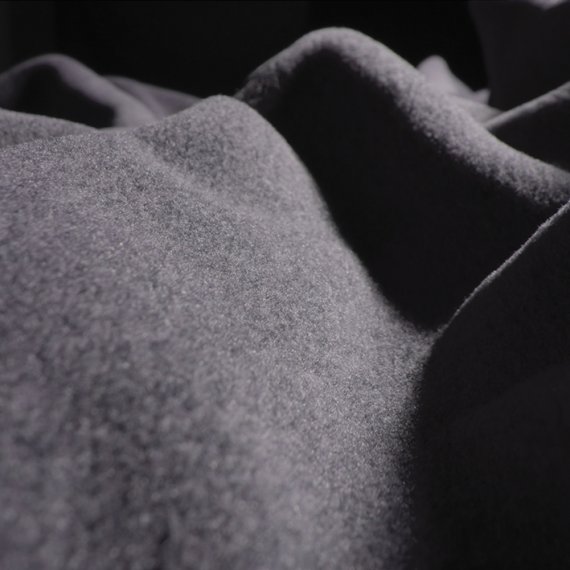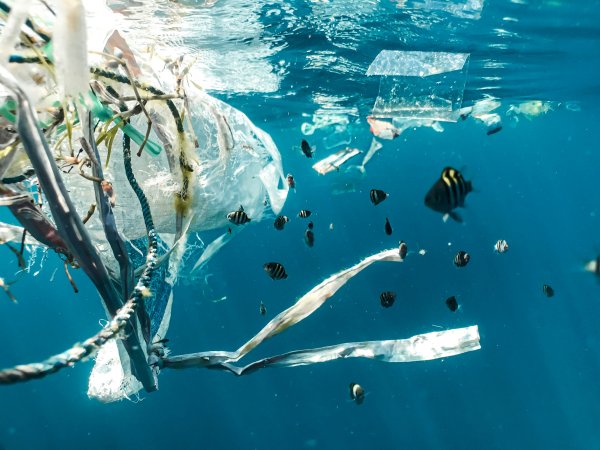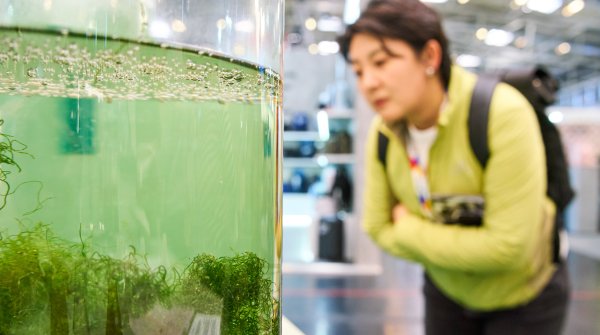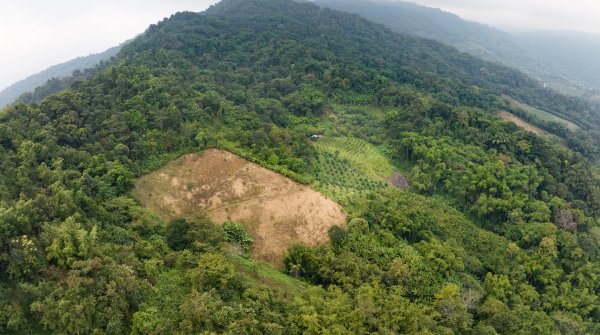- Microplastics are now everywhere
- Textile industry causes most of the microplastics
- Causes of fiber fragmentation
- Natural fibers are not fundamentally better than man-made fibers
- Biodegradability and fiber fragmentation
- New fabric constructions and finishes
- Fiber-friendly washing practices and industry training
Ubiquity of microplastics: Microplastics can be found in all environments, from bodies of water to human tissue.
Main source textile industry: Textiles, especially synthetic fibers, are the main sources of microplastics.
Causes of fiber fragmentation: Yarn twist, fiber length and surface treatment influence microfiber output.
Challenges with natural fibers: Natural fibers are not automatically more environmentally friendly, as chemical treatments make them more difficult to break down.
Innovative solutions: New materials and processes, such as Polartec® Shed Less Fleece and Polygiene ShedGuard, reduce fiber loss.
"Wherever researchers look for microplastics, they find them," says Elliot Bland, researcher at The Microfiber Consortium (TMC) during his presentation at the last OutDoor by ISPO. Together with the University of Leeds and with the support of the European Outdoor Group (EOG), the NGO is investigating how the clothing industry can help to reduce microplastics.
Microplastics in the clothing industry are defined by the National Oceanic and Atmospheric Administration as small plastic particles with a diameter of less than five millimeters. Although we are most familiar with microplastics from our rivers, lakes and oceans, the majority of them do not come from there, but are produced on land and accumulate in the water. But it can also be found in other places: In Arctic and Antarctic ice samples, in water, in the air, in land and sea animals, in human organs and tissues. It does not belong anywhere else, as the particles enter the food chain of humans and animals via the water and the organisms living in it, thus not only damaging individual organisms but also threatening entire ecosystems.
There are many different sources of microplastics: they are found in cosmetics and cleaning products, they are caused by tire abrasion, fishing nets or the decomposition of plastic waste. However, research has shown that there is one main source of microplastics: Clothing. The majority of these particles are fragments of textile fibers. According to projections from a study by the International Union for Conservation of Nature, 35% of microplastics in the sea actually come from fiber abrasion from synthetic textiles. "These microfibers are created during washing, in the washing machine, but also during production, during spinning, weaving, dyeing - in fact at every stage of textile production," explains Bland. He is therefore interested in how fabrics and yarns will have to be constructed in the future in order to reduce microplastic in clothing - which incidentally also means a loss of product quality. In order to achieve this, "The Microfiber 2030 Commitment" was launched together with cooperating companies from the entire sports, outdoor and fashion industry. All signatories are committed to working as a global collective to reduce the impact of fiber fragmentation of textiles on the natural environment to zero by 2030.

A total of 827 fabrics from 241 fabric manufacturers have already been tested for fiber loss using a standardized measurement method. The first results are already emerging. For example, we know that filament yarns* emit fewer fibers than staple fibers**, as do higher twisted yarns compared to loosely twisted yarns. It is also known that roughened or brushed fabric surfaces lose more fibers and that fiber loss increases sharply the more often the process is repeated. TMC has also found that fabrics made from recycled polyester are no more susceptible to fiber fragmentation than comparable fabrics made from virgin polyester. In principle, many different factors influence fiber fragmentation, including fiber length, yarn twist, chemical composition, mechanical strength of the fiber, fabric construction and chemical finishing. "We need solutions for this," says Bland, and does not mean that certain fibers or fabrics should be generally banned in the future. "If we find that filament yarns have less fiber loss than staple fibers, then we can't simply stop processing staple fibers, we would have to abandon all natural fibers. Of course, that doesn't make sense."
There is another important finding that TMC would like to draw attention to: Natural fibers are not inherently better than man-made fibers. For a long time, the prevailing opinion was that natural fibers, because they are of natural origin, do not pollute the environment to the same extent as petroleum-based man-made fibers do. It was assumed that natural fibers such as cotton or wool biodegrade more quickly than their synthetic counterparts and are therefore less durable and persistent in the environment. But it's not that simple. "Natural fibers also end up in the environment and remain there for a long time. This is due to the many chemical processes that natural fibers undergo, which ensure that they don't degrade either," explains the researcher. "It therefore makes no sense to differentiate between the two types of fibers, in aspect of microplastics in clothing. Dyeing natural materials on a plant basis and applying various finishes can also prevent degradation. Studies have shown that naturally dyed cotton, for example, contains significantly more vegetable wax than conventional cotton, which slows down the degradation process.
Relying on biodegradable materials is not (yet) a solution to the problem for a number of reasons, even though the industry is now developing more and more synthetic fibers that are biodegradable. Firstly, biodegradability depends on the right conditions for the type of material in question. This means that not all fibers that are declared biodegradable do so under the same conditions. For example, there are major differences between the conditions for industrial and domestic composting. Of course, nobody would think of composting their T-shirt in their own garden, but ultimately this is exactly what happens in all countries that do not have a functioning waste management system. On the other hand, biodegradability says nothing about which substances are released during the degradation process and what effect these have in the various environments on land and in water. "The issues of biodegradability and fiber fragmentation are both complex in their own right, and overlaying them to create solutions without remorse requires further work to ensure that major sustainability issues are not created," TMC writes in an official statement.
It is therefore just as important to look for ways to make fibers and fabrics more robust and release fewer fragments. The industry has already presented initial concepts for this. For example, fabric manufacturer Polartec - the inventor of fleece after all - presented its Polartec® Shed Less fleece in 2023. Shed Less is a process that combines yarn construction, knitting, chemistry and production to reduce the shedding of fiber fragments in household laundry by an average of 85%. The first fabric to receive this new technology is the Polartec® 200 Series fleece. Polartec has also developed new processes in its factories to reduce the dispersion of microplastics in clothing. These include the installation of vacuum and filter systems for all surface finishing machines and the upcycling of all collected fabric waste for reuse in other products. Back in 2018, the company introduced Polartec Power Air, which is designed to trap the fibers in air pockets, i.e. between two layers of fabric.

Textile supplier Polygiene is working on a chemical method to reduce the fragmentation of fibers. In November 2023, Polygiene presented its new innovation project Polygiene ShedGuard at ISPO Munich. It was developed to minimize the loss of microfibers and improve the resistance of the fabric during washing. Polygiene ShedGuard creates a film of polymers around the fiber bundles. It prevents fragments from separating from the fabric structure, splitting and tearing off. According to Polygiene, the process reduces the loss of microfibers by up to 70 %. For this, the technology was awarded the ISPO Textrends Award 2025/26 as the best product in the "Performing Finishes" category. ShedGuard is still in the test phase.
There are also new developments from washing machine manufacturers. In 2023, Samsung worked with Patagonia to develop an external filter that reduces the release of microfiber emissions into wastewater. The filter can be purchased separately and retrofitted.

Consumers can also help to ensure that their products lose fewer fiber fragments. TMC has found that liquid detergents are better than washing powder, water-saving washing machines are better than those with high water consumption and full wash loads produce less fiber breakage than half-full washing machines. Special microfiber filters are also useful, as long as they are cleaned regularly and the fibers are disposed of correctly. However, "it is still too early to make detailed statements here," says Bland.
Ultimately, all research into microfibers and their impact on our environment is still in its early stages. Even TMC, which launched 'The Microfiber 2030 Commitment' in 2021, only entered the phase of "developing an understanding of the causes" in 2024. And there is still no globally recognized, uniform standard for measuring fibre fragmentation, which makes it difficult to compare research results. The good news is that the problem has been recognized and more and more companies try to do something about microplastics in clothing. TMC is also already sharing its findings in training courses for the industry and public webinars.
- ISPO awards
- Mountain sports
- Bike
- Design
- Retail
- Fitness
- Health
- ISPO Job Market
- ISPO Munich
- ISPO Shanghai
- Running
- Brands
- Sustainability
- Olympia
- OutDoor
- Promotion
- Sports Business
- ISPO Textrends
- Triathlon
- Water sports
- Winter sports
- eSports
- SportsTech
- OutDoor by ISPO
- Heroes
- Transformation
- Sport Fashion
- Urban Culture
- Challenges of a CEO
- Trade fairs
- Sports
- Find the Balance
- Product reviews
- Newsletter Exclusive Area
- Magazine






